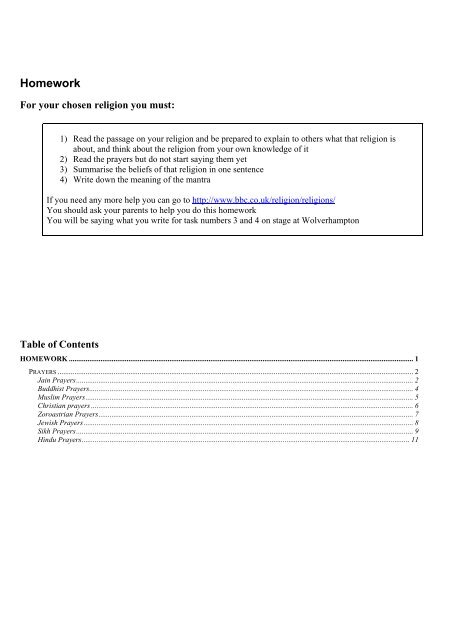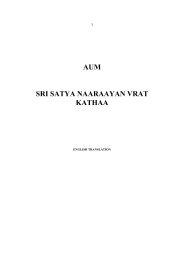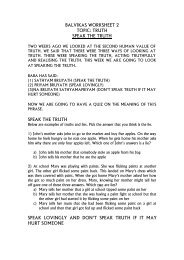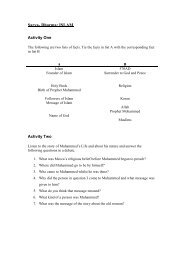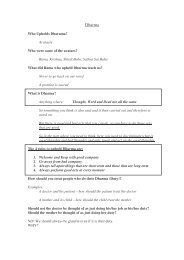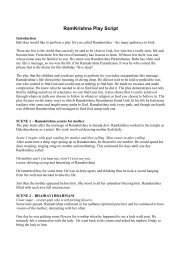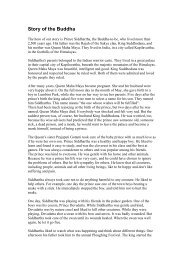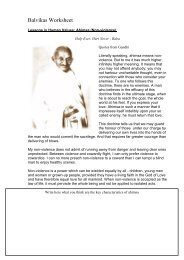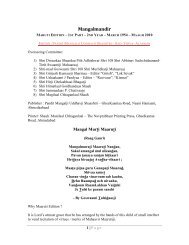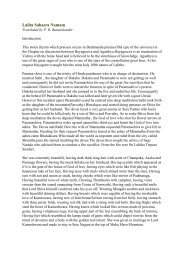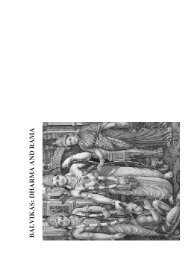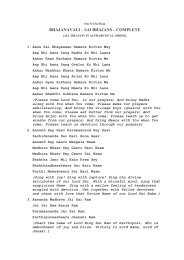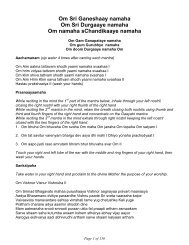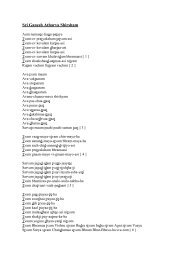SARVA DHARMA: Homework (Prayers)
SARVA DHARMA: Homework (Prayers)
SARVA DHARMA: Homework (Prayers)
Create successful ePaper yourself
Turn your PDF publications into a flip-book with our unique Google optimized e-Paper software.
<strong>Prayers</strong>Jain <strong>Prayers</strong>NAMO ARIHANTANAMI bow to the Arihantas, the perfected human beings, Godmen.NAMO SIDDHANAMI bow to the Siddhas, liberated bodiless souls, God.NAMO AIRIYANAMI bow to the Acharyas, the masters and heads of congregations.NAMO UVAJJHAYANAMI bow to the Upadhyayas, the spiritual teachers.NAMO LOE SAVVA SAHUNAMI bow to the spiritual practitioners in the universe, Sadhus.ESO PANCA NAMOKAROThis five-fold obeisance mantra,SAVVA PAVAPANASNODestroys all sins and obstacles,MANGALANAMCA SAVVESIMAnd of all auspicious repetitions,PADHAMAM HAVAI MANGALAMIs the first and foremostImage Source:http://www.mahavir.com/Founder Mahavira Jainism, in contrast to Hinduism, is based upon a founder and leader known as Mahavira.This name actually is an honorific title signifying "great man." Tradition places the birth of Mahavira at 599B.C. in northeastern India, which would make him a contemporary of Buddha. Tradition also relates thatMahavira was the second son of a rajah living in luxurious surroundings. He married and had one daughter.When his parents died, Mahavira decided at the age of 30 to live a life of self-denial, pledging to deny himselfthe care of his body and not to speak for 12 years. After a short time, Mahavira put off the robe he wore andwandered naked through India receiving injuries from both man and beast. He wandered for 12 years until hereached enlightenment at the age of 42.The Sacred Books of the East record, "During the thirteenth year, in a squatting position ... exposing himself tothe heat of the sun ... with knees high and the head low, in deep meditation, in the midst of abstract meditationhe reached nirvana, the complete and full, the unobstructed, infinite absolute" (F. M. Mueller, ed., Sacred Booksof the East, Vol. 22, Oxford: Krishna Press, 1879-1910, p. 201).After reaching enlightenment, Mahavira stopped living by himself and took on disciples, preaching his newfoundbelief. So he continued to live until the end of his life, at which time he was said to have over 14,000monks in his brotherhood (Maurice Rawlings, Life-Wish: Reincarnation: Reality or Hoax, Nashville: ThomasNelson Inc., 1981, p. 63).The Principles of Jainism:Among the sacred books of Jainism, the 12 angas hold the foremost position. In the second anga, called sutrakeit-anga,the following sayings are contained which give insight into the nature of Jainism:Know what causes the bondage of the soul; and knowing, try to remove it.All things are eternal by their very nature.As imprisoned birds do not get out of their cage, so those ignorant of right or wrong do not get out of theirmisery.There are three ways of committing sins: by our actions; by authorizing others, and by approval.A sage leads a life as far removed from love as from hate.All living beings hate pain: therefore do not injure them or kill them. This is the essence of wisdom: not to kill
anything.Leave off pride, anger, deceit and greed.Men suffer individually for the deeds they themselves have done.The wise man should consider that not he alone suffers; all creatures in the world suffer.Conceit is a very thin thorn; it is difficult to pull out.No man should seek fame and respect by his austerities.A man should treat all creatures in the world as he himself would like to be treated.He who is purified by meditation is like a ship in the water that avoids all dangers until it reaches the shore.Do not maintain that there is no such thing as good or evil, but that there is good and evil.(from: http://www.greatcom.org/resources/handbook_of_todays_religions/03chap02/default.htm)
Buddhist <strong>Prayers</strong>Buddham Saranam GacchamiSangham Saranam GacchamiDharmam Saranam GacchamiBuddham-Sangham-Dharmam"Make an effort to see the same divine principle everywhere and in everything, until you realize the ultimatetruth, that only the Atma exists, that only the Self is real."Buddha taught the same great truth, although he may not have made reference to Veda or used Vedantic terms,nevertheless, he experienced and demonstrated the essential spirit of Veda. First he said, 'Buddham, SharanamGacchami', meaning, 'I take refuge in the Buddhi, my power of discrimination.' This deals with the individual; itspeaks of the limited personality. Gradually, he added, 'Sangham Sharanam Gacchami', meaning, 'I take refugein the community, I take refuge in the society.' He recognized that feelings associated with individual andpersonal considerations are selfish and narrow, and cannot take you very far.You should not consider this individual self as everything; it is only a drop in the ocean. Along these lines,Krishna also commanded, "Arjuna, expand your heart. Become broadminded. Include the entire society withinyour scope." Society does not have any particular form; it is made up of individuals. When a large number ofindividuals join together they become a society. Swami often say, 'Expansion is My life'. When you expandindividual life to infinity it becomes divinity; that is to say, let individual life multiply and broaden and it willeventually reach divinity. Therefore, Krishna told Arjuna, "Live in the society; serve the society; and developbroadmindedness."The meaning of society in one country may be different from that in another; and a society or community calledby one name may have nothing to do with a society or community called by another name. So, you will findthat there are limits even for a society, and that the society by itself will not take you all the way to infinity.Therefore, Buddha added one more step, 'Dharmam Sharanam Gacchami', meaning, 'I take refuge in Dharma, Itake shelter in truth and righteousness'. Dharma, as used here, has a very broad connotation; it refers to the onewho supports the entire world. When you investigate the general meaning of the word Dharma, you find that itrelates to the basic nature of a thing; its essential truth. The 'thing' referred to here is the immortal Atma, theindwelling divinity. Therefore, the deeper meaning of Dharma is found in the true nature of divinity. To takerefuge in Dharma is to become one with the attributes of divinity. It has been said that Maya is the body of God,but it is more correct to say that Dharma is the body of God. It is His very form. That is why Krishnaannouonced, 'For establishing Dharma I have come again and again.' Dharma reveals the broad nature ofdivinity in all its glorious aspects.In a life filled with desires, the pleasures one seeks are inevitably followed by grief and disappointments. Allunrighteous actions lead to sorrow. It was for this reason that Buddha emphasized the need for discrimination.The first prayer, "Buddham Saranam Gachami" is a call for cultivating wisdom and discriminations - theBuddhi. But unless the power of discrimination is used for doing right action for the good of society it is of nouse. Hence the second prayer, "Sangham Saranam Gacchami" (I surrender myself to society). What is this rightaction that must be done? That is indicated by the third prayer: "Dharmam Saranam Gacchami" (I take refuge inDharma). To reach your goal, the royal road is Dharma - Righteousness. It is only when these are combined -Wisdom, Social Service and Righteousness - that there is fulfilment in life.BHAGAVAD GITA DISCOURSESby BabaImage and text from : http://www.saibaba.ws/teachings/buddha/buddha.htm
Muslim <strong>Prayers</strong> (Image and text from: http://saitowers.com/spi/magazine/julaug2001/prayerformuslim.htm)Bismillaa hir Rahmaanir Rahim1. Al Hamdu lillaahi Rabbil Aalameen2. Ar Rahamaanir Rahim3. Maaliki Yav middeen4. Iyyaaka nabudu Va Iyyaaka nasta een5. Ihdinas siraatal mustakeem6. Siraatalla zeena an amta alai him7. Gairil magzubi alaihim va lazzaalleenMeaning: In the name of Allah, the most beneficent andmerciful1. All praise be to Allah, the most just ruler of theworlds2. The most beneficent and merciful3. The Lord of the day of judgement4. You alone we worship; you alone we ask for help.5. Show us the straight path6. The path of those whom you have favoured7. Not (the path) of those who earn your anger or ofthose who go astrayNotes:Before the time of Prophet Mohammad, Arabs used the phrase ‘Bismillah’ only, which meant ‘In the name ofAllah’. At that time people believed that Allah was supposed not to be very responsive to personal problemsand prayers. But the prophet described God as the most beneficent and merciful (Rahmaanir Rahim), quitesensitive to our problems and responsive to our prayers. Such a perception of God was more conducive todevelop an intimacy and relationship with God and Islam grew into a great religion closely knitting largesections of humanity.1. In the first sentence of this prayer, the devotee recognises the presence of the hand of God behind all that issuccessful and praiseworthy. God’s grace is the main switch and man’s effort is the room switch. Without themain switch on, putting on the room switch is of no avail. It is interesting to note a similar conviction in theBhagawad Gita (18:78) and in the Bible (Book of Job etc).2. The idea of the day of judgement is common to Hinduism (Refer Chitragupta’s records of all our actions and thejudgement by Yama) as well as to Christianity (corroborated by modern discoveries in parapsychology).3. The sole dependence on God by the devotee is again a common feature in the principal religions.4. The straight path is also known as the narrow path in Christianity and as the razor’s edge in Hinduism. It isdifficult to walk along it but the reward is worth all the effort. As the Gita says it is like poison in the beginningand like nectar in the end.5. The last part of this prayer is an echo of the last part of Lord’s prayer in the Bible, which says ‘Lead us not intotemptation but deliver us from evil.’
Christian prayersOur father who art in heavenHallowed be thy nameThy kingdom come thy will be done on earth as it is in heavenGive us this day our daily breadAnd forgive us our tresspasesAs we forgive those who trespass against usLead us not into temptationBut deliver us from evilFor thy is the kingdom the power and the gloryForever and ever amen(Mathew 6:9-13)Christ's basic teachings were related to promotion of compassion, sympathy, love,sacrifice and fellowship among human beings. Jesus was named the Christ as he wasregarded as the "chosen ” messenger of God. BabaDiscourse in the Poornachandra Auditorium, on 25-12-1991.The essence of this prayer is a reverence for God and the ability to forgive
Jewish <strong>Prayers</strong>Sh'ma Yisrael Adonai Elohaynu Adonai Echad.Hear, Israel, the Lord is our God, the Lord is One.Barukh Shem k'vod malkhuto l'olam va-edBlessed be the Name of His glorious kingdom for ever and everJews believe in the idea of chosen people, thereby they must st an example to mankind. They believe that theyshould obey laws set down in the torahThe Relationship with GodJews believe that there is a single God who not only created the universe, but with whom every Jew can have anindividual and personal relationship.They believe that God continues to work in the world, affecting everything that people do.The Jewish relationship with God is a covenant relationship.In exchange for the many good deeds that God has done and continues to do for the Jewish People... The Jews keep God's laws The Jews seek to bring holiness into every aspect of their lives.Judaism is the Faith of a CommunityJews believe that God appointed the Jews to be his chosen people in order to set an example of holiness andethical behavior to the world.Jewish life is very much the life of a community and there are many activities that Jews must do as acommunity. For example, the Jewish prayer book uses WE and OUR in prayers where some other faiths woulduse I and MINE.Jews also feel part of a global community with a close bond Jewish people all over the world. A lot of Jewishreligious life is based around the home and family activities.Judaism is a Family FaithJudaism is very much a family faith and the ceremonies start early, when a Jewish boy baby is circumcised ateight days old, following the instructions that God gave to Abraham around 4,000 years ago.Many Jewish religious customs revolve around the home. One example is the Sabbath meal, when families jointogether to welcome in the special dayFrom http://www.bbc.co.uk/religion/religions/judaism/beliefs/index.shtml
Sikh <strong>Prayers</strong>Mul mantraEk onkar satnam karta purukh, nirbhau, nirvair, akal murat, ajuni, saibham, Gurprasad.It can be paraphrased, but is believed to be beyond translation. "One true and universal creator, all powerful, withoutfear and without hatred. God is eternal and infinite. Self existent and known only by grace."(Image Source: http://www.bbc.co.uk/worldservice/people/features/world_religions/sikhism_az2.shtml)The Mul Mantra appears at the beginning of the Guru Granth Sahib Ji before the "Jap" (known as Jap Ji Sahib).The Mul Mantra contains the basic concepts relating to Almighty God, Waheguru and is the epitome of the SikhFaith. We all have read and heard this important Gurbani many times, but we need to understand and thinkabout the important message it conveys and to act upon these teachings in everyday life."Ek-Onkaar" - God is One. The fact that the Guru Granth Sahib starts with the numeral "1" (1) emphasises theOneness of God and the importance of this teaching. It is an Absolute value. The word "Onkaar" means thatGod manifests himself throughout his creation yet. Ek - God is One, for all people no matter their religion, casteor colour."SatNaam" - The True Name. "Sat" means True or Real and everlasting and Naam means Name but also infersthe Essence of God. This Divine Essence is formless, colourless and is present in all Creation. So God is Trueand is immanent in all beings."Karta Purakh" - The Supreme Creator. Karta - God is the Creator, and Purakh - is immanent in His Creationand fills all beings. This also represents Power, God is the all Powerful Creator."Nirbhau". He is without fear. Fear is only possible if there is another being to be afraid of, God is absolute,who is He to be afraid of? There is also no opposite to God (like Satan)."Nirvair". God is inimical to none, God has no enemies, again as he is the sole Supreme being who is he to havehatred or ill-feeling against?"Akaal Murat". God does not die, always exists. God is Eternal, Infinite."Ajooni". He is never born. He is above the circle of reincarnation and there is none before him."Saibhang". He is self-illuminated - he is from himself, is self- existent and self-sufficient."Gur Prasad". He is realised by the kindness of the True Guru. One cannot claim Him, that is not our right.This is opening of the Guru Granth Sahib and is followed by the first Salok and then by the Jap.So the central Sikh teaching about God emphasises again and again the Oneness of God and his unique positionin the Universe. It also tells us in the last line that God can be realised by all, and is not unattainable. To findhim, one has to absorb oneself in His Name. This is what Guru Nanak calls as "Jap". Call Him with deep loveand devotion and He will manifest Himself to you.Guru Nanak taught us to live within society and criticised those who left society behind to meditate in order toreach God. He said we should all meditate and remember God in our daily lives. This will motivate us to act
ighteously. As such Guru Nanak has given us a clear purpose of life. This is the Goal of merging with Godthrough truthful living and remembering God’s name.(Source: http://www.bsingh.dsl.pipex.com/khalsa/news2.htm)
Hindu <strong>Prayers</strong>AUMAum is the sound of the creation. (When the Elements originated and Creation started, thesound Om was produced.) By chanting Aum, we are awakening the God within us. Thechanting generates spiritual vibrations that purify the atmosphere in the classroom andsimultaneously lifts the child’s mind to a higher level.A – stands for Brahma the creator, it also represents the waking state of consciousness (Jagrath)U – stands for Vishnu the protector or sustainer, it also represents the dream state (Swapna)M - stands for Maheshwara (or Shiva) the Destroyer and also represents the deep sleep state (Sushupti)The creative, protective and destructive forces are found everywhere in the universe.Aum also shows how conscious we are of who we are, As we are God it shows the stages of being aware ofGod. As a whole word when said together it shows that we are trying to go beyond the three stages ofconsciousness to Turiya – the highest state of consciousness where you are aware you are God.Aum bhoorbhuvaha swaahaThath savithur varenyamBhargo dhevasya dheemahiDhiyo yonaha prachodhayathMay the supreme light that illumines the three worlds illumine our intellect and direct our intelligence to thepath of virtueTHE Gaayathri (Vedhic prayer to illuminate the intellect) is the Universal prayer enshrined in theVedhas(Divine Knowledge), the most ancient scriptures of man. It is addressed to the Immanent and TranscendentDivine which has been given the name 'Savitha,' meaning 'that from which all this is born.' The Gaayathri maybe considered as having three parts---(i) Praise (11) Meditation (iii)Prayer. First the Divine is praised, then It ismeditated upon in reverence and finally an appeal is made to the Divine to awaken and strengthen the intellect,the discriminating faculty of man.The Gaayathri is considered as Vedhasaara---"the essence of the Vedhas." Vedha means knowledge, and thisprayer fosters and sharpens the knowledge-yielding faculty. As a matter of fact the four Mahaavaakyas or 'coredeclarations'enshrined in the four Vedhas are implied in this Gaayathri manthra.Every human being has four birthdaysThe Gaayathri is usually repeated at dawn, midnoon and dusk. But God being beyondtime, it is a result of our limitations that we talk of dawn and dusk. When wemove away from the Sun it Is dusk; when we move into the light of the Sun it isdawn. So you need not be bound by the three points of time to recite the prayer.It can be repeated always and everywhere, only one has to ensure that the mind ispure. I would advise you young people to recite it when you take your bath. Donot sing cheap and defiling film songs. Recite the Gaayathri. When you bathe, thebody is being cleansed; let your mind and intellect also be cleansed. Make it apoint to repeat it when you bathe as well as before every meal, when you wakefrom sleep and when you go to bed. And also repeat 'Shaanthi' thrice at the end,for that repetition will give Shaanthi or peace to three entities in you---body,mind and soul. Every human being has four birthdays. The first is when he emergesfrom his mother's womb and, being neither holy nor unholy, craves only for foodand shelter; the second Is when he begins his spiritual study to lead him fromdarkness to light; the third is when he has gained wisdom, having mastered thedisciplines propounded by the rishis for achieving self-realisation; the fourthand last is when he realises his true identity and merges with Brahman.
Never give up the Gaayathri manthraThe yajnopaveetham (sacred thread) is a symbol of purity which is necessary if you wish toparticipate in the yajna of Living. Life is a continuous series of sacrifices of the lower for thesake of the higher, of the tiny in favour of the vast. Upanayana, the word which has been givento this ceremony of Initiation, means the conferment of another eye. Your two eyes cannot revealto you the magnificence and the majesty of the realm of the spirit. They are focussed towards theobjective world and its transient attractions. So the Gaayathri manthra has been given to you asa third eye to reveal to you that inner vision by which you may realise Brahman.Gaayathri is a treasure you must guard throughout your lives. If you have not caught the soundsof the manthra correctly now, learn it from your parents or from your family priest. Perhaps theothers may not know the Gaayathri themselves or they might have forgotten it through culpableneglect. Then I would ask them to learn it from you.Never give up the Gaayathri; you may give up or ignore any other manthra but you should recitethe Gaayathri at least a few times a day. It will protect you from harm wherever you are---travelling, working or at home. Westerners have investigated the vibrations produced by thismanthra and have found that when it is recited with the correct accent as laid down in theVedhas, the atmosphere around becomes visibly illumined. So Brahmaprakaasha, the effulgenceof divine will descend on you and illumine your intellect and light your path when this manthrais chanted. Gaayathri is Annapoorna, the Mother, the sustaining Force that animates all life. Sodo not neglect it. Elders and priests, manthra, have given it the custodians of this the go-by. Butyou, as Inheritors and guardians of the great culture of this country, have a great responsibility inpreserving it and demonstrating its efficacy and worth.Upanayanam Day, Brindhaavan, 20-6-1977Hinduism believes in one god that takes many forms, it believes that God is present in everything. It belives inkarma (the law of action and reaction and of rebirth), it believes that God incarnates on the earth in very age. Itbelieves in spiritual practice or sadhana.It believes in atma: Atma is a part of God that exists within us all. It is like drops of water in the oceanthey are still individual drops but the drops are part of the ocean. It is not made and can never bedestroyed.
<strong>SARVA</strong> <strong>DHARMA</strong> PRAYERSOm Tat Sat Sri Narayana TuPurushottama Guru TuSiddha Buddha Tu Skanda VinayakaSavita Pavaka TuBrahma Mazda Tu Yahve Shakti TuIshu Pita Prabhu TuRudra Vishnu Tu Rama Krishna TuRahima Tao TuVasudeva Go-Vishvarupa TuChidananda Hari TuAdvitiya Tu Akala NirbhayaAtmalinga Shiva TuOm, Thou art that, Thou art Narayana,God in the form of man;Thou art the Embodiment of perfection and the perfect master.Thou art enlightened Buddha;Thou art Subramanya and Ganesha, the remover of obstacles;Thou art the Sun-fire;Thou art Brahma, the Creator;Mazda, the Great One;Thou art Jehovah and the Divine Mother, the creative Energy.O Lord! Thou art the Father of Jesus.Thou art Rudra, the Transformer, and Vishnu, the Preserver;Thou art Rama and Krishna;Thou art Rahim, all kindness, always giving and expanding;Thou art the Tao.Thou art Vasudeva, the Sustenance of all, omnipotent andomnipresent;Thou art Hari, Destroyer of illusion, the blissful Spirit.Thou art unparallelled, beyond time and fearless of adversities;Thou art Shiva, Creator of the lingam, Symbol of the formlessAbsolute"Sahanaa vavathu; sahanau bhunakthu; sahaviryam karavaavahai" (Let us livetogether; let usstruggle together; let us grow together in joy and harmony). This was theteaching of the Vedas.Lokaa samstaa sukhino bhavantu – may all beings be happy always
Let the different faiths exist, let them flourish, and let the glory of God be sung in all thelanguages and in a variety of tunes. That should be the Ideal. Respect the differencesbetween the faiths and recognize them as valid as long as they do not extinguish theflame of unity.Sathya Sai BabaHindu Om: Listen to the primeval Pranava (Om) resounding in your heart as well as in the heart of theUniverse.Buddhist wheel: Remember the wheel of cause and consequence, of deed and destiny, and the wheel ofdharma that rights them all.Zoroastrian fire symbol: Offer all bitterness in the sacred fire and emerge grand, great, and godly.Islamic crescent and star: Be like the star, which never wavers from the crescent but is fixed in steadyfaith.Christian cross: Cut the "I" feeling clean across and let your ego die on the cross, to endow on youEternity.


